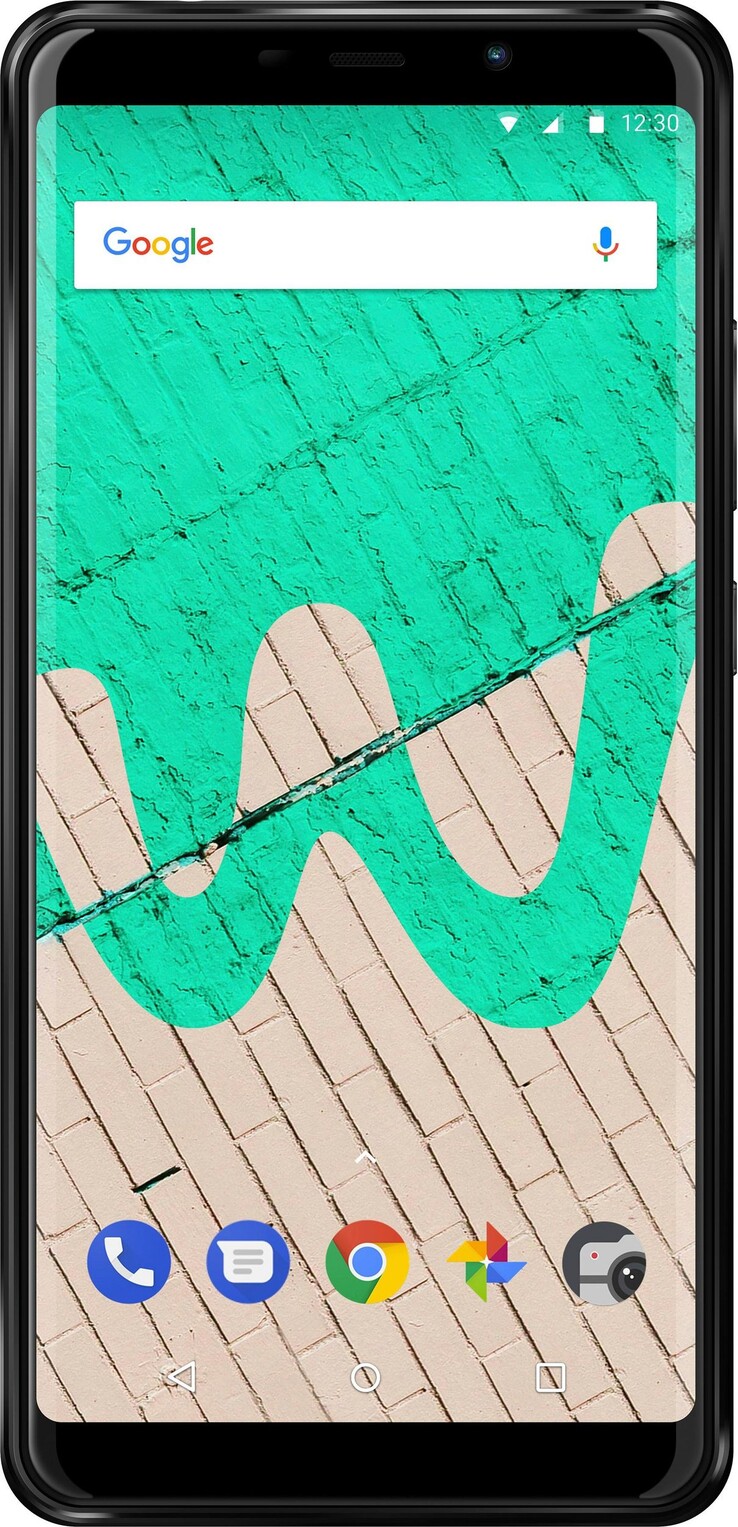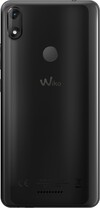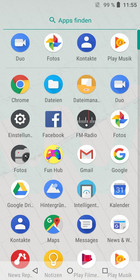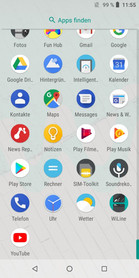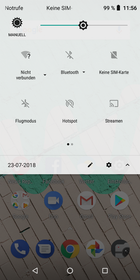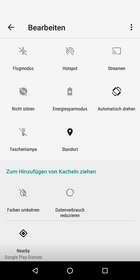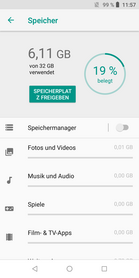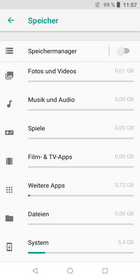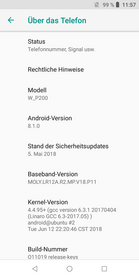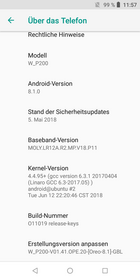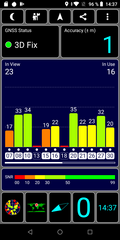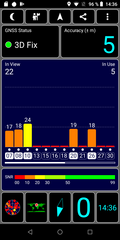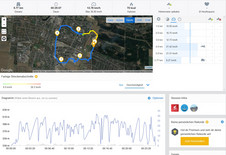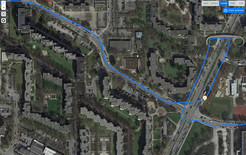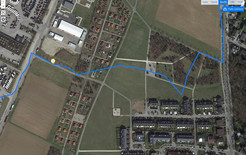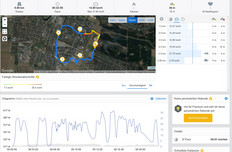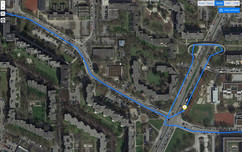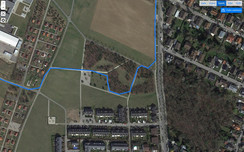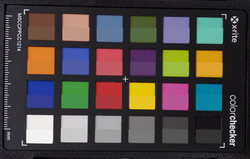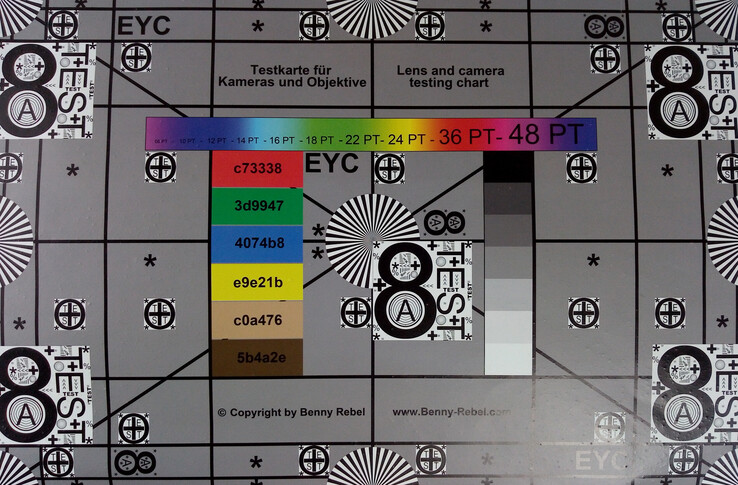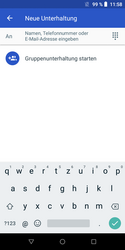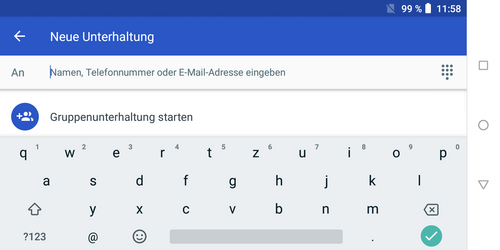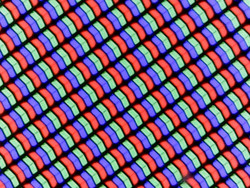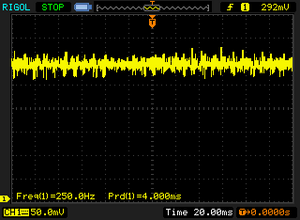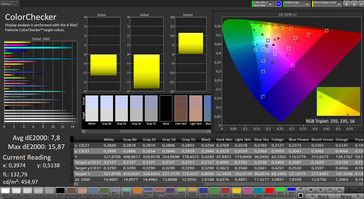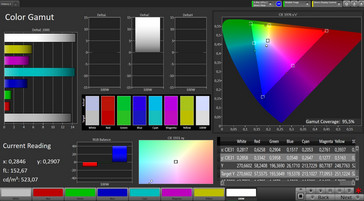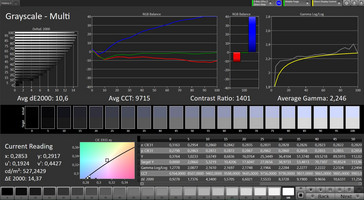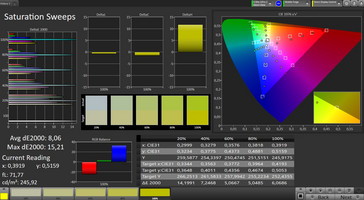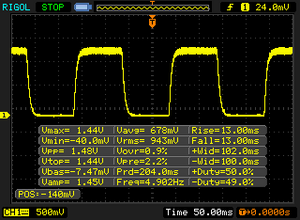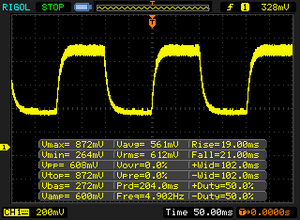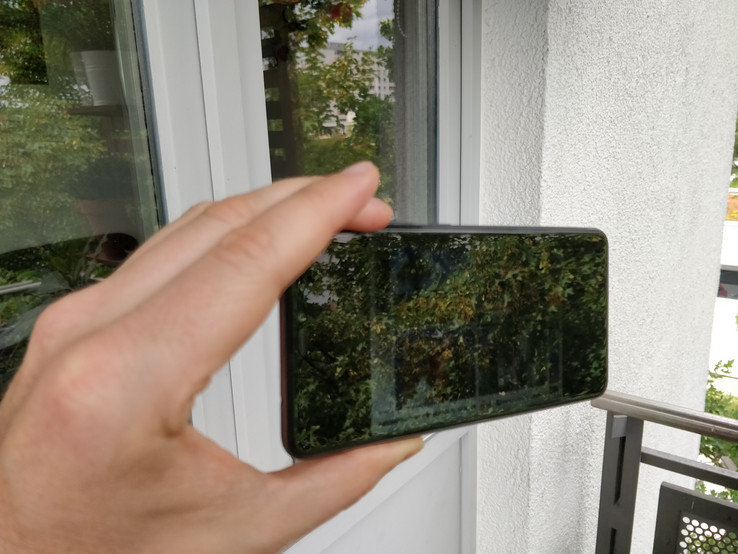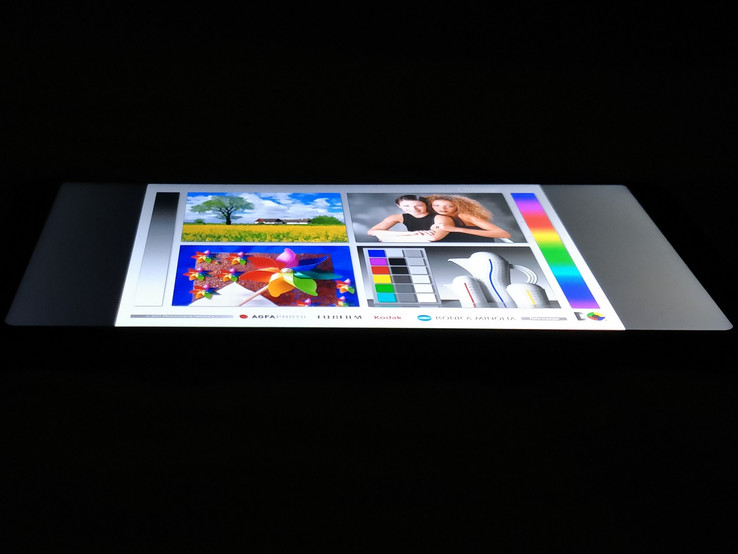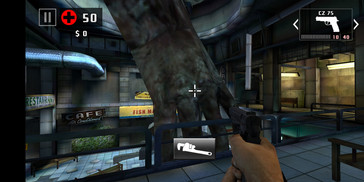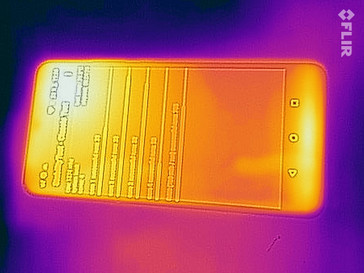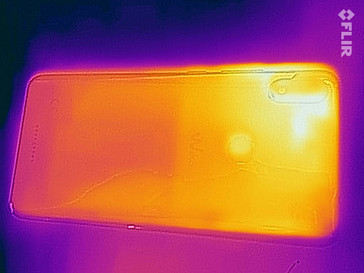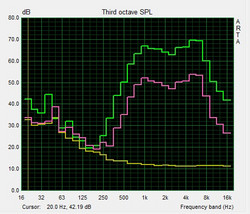Wiko View Max Smartphone Review
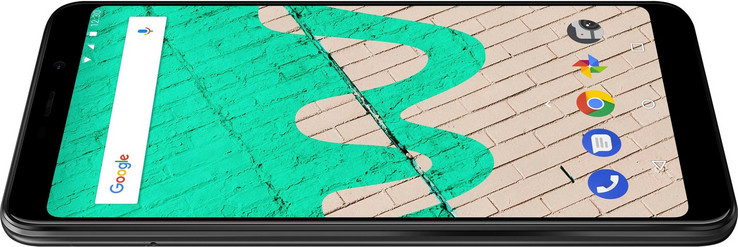
With the Wiko View 2 Pro, the french manufacturer Wiko last proved that European manufacturers too, can make low-priced smartphones with good features. Our current test device has picked up on the market trend of smaller bezels and implements them in a 6-inch device. On the inside of the Wiko View Max, a Mediatek MT6739 SoC handles computing and is supported by a PowerVR GE8100 graphics unit. 2 GB of RAM and 64 GB of eMMC flash storage complete the hardware configuration.
Smartphones which offer similar performance for a similar price are the competing devices of the Wiko View Max. Since many manufacturers have offerings in this segment of the market, we limit our comparison to four devices. They consist of the Honor 7C, Alcatel's 3V, the Gigaset GS185 and Motorola's Moto G6 Play.
Case - Big and light Wiko smartphone
The case of the Wiko View Max is made out of plastic and the available colors are black, gold and red. On the front, most elements have been reduced in size in order to make as much room as possible for the display. The back houses a single main camera with LED flash, a fingerprint sensor and a second speaker. The physical control elements on the right side of the device sit firmly in their respective sockets and the SIM/microSD card tray has no leeway in its slot either. Size and weight of the Wiko View Max match the average of comparable devices.
Features - Wiko smartphone with dual SIM
Wiko has equipped the View Max with a Mediatek MT6739 SoC as well as a PowerVR GE8100 graphics unit. They are complemented by 3 GB of RAM and 32 GB of eMMC flash storage. This configuration is suitable for a phone in this price range and allows for a smooth operating Android system. The card slot to the left accomodates two nano-SIM and one microSD cards simultaneously - The internal storage can be expanded to up to 128 GB using the latter.
A MicroUSB 2.0 port is used for wired data transfer and serves as charging connection. External audio devices can be connected to the Wiko View Max not only via Bluetooth 4.2, but also the 3.5 mm audio jack.
Software - Wiko View Max with Android Oreo
The Wikow View Max comes with Android Oreo version 8.1 with security updates from May 5th 2018. A fairly pure Android system awaits users, since only a few apps from the manufacturer and almost no third party apps have been preinstalled. The latter, which, for example, includes the facebook app, can only be deactivated as opposed to uninstalled however. Using a memory card only expands the storage for user data such as pictures or music. Transferring app data or formatting the memory card as internal storage are not possible.
Communication and GPS - LTE smartphone by Wiko
The Wiko View Max can connect to GSM, 3G and LTE cellular networks. LTE connections up to Cat. 4 are available, allowing for maximum download speeds of up to 150 Mbit/s and maximum upload speeds of up to 50 Mbit/s. Bluetooth 4.2 as well as Wi-Fi supporting the standards b,g and n are available for close proximity data networking. Here, the performance is slightly below average for comparable devices. The differences are small however. Only the Alcatel 3V has a significantly faster connection.
| Networking | |
| iperf3 transmit AX12 | |
| Alcatel 3V | |
| Gigaset GS185 | |
| Honor 7C | |
| Wiko View Max | |
| Motorola Moto G6 Play | |
| iperf3 receive AX12 | |
| Alcatel 3V | |
| Gigaset GS185 | |
| Honor 7C | |
| Wiko View Max | |
| Motorola Moto G6 Play | |
With the app "GPS-Test", we determine the accuracy of the Wiko View Max's locating capabilities. We measured it to be accurate within five meters (~16.40 ft) inside of buildings. Outdoors, this value improves to being accurate within one meter (~3.28 ft).
Whereas locating worked well standing still, we ran into some minor issues during our compulsory bike ride. Compared to our reference device Garmin Edge 520, the GPS of the Wiko View Max has several gaps in the recorded route. This causes navigation to become inaccurate and possibly unreliable in practice.
Telephony and Call Quality - Wiko View Max with good Call Quality
The stock Android telephony app is available for entering phone numbers and searching through your own contacts on the Wiko View Max. With it, calls can be made in a familiar, straightforward way. During phone calls, both participants can be clearly understood and ambient noise is also filtered out well. That said, total volume level could be slightly higher, since it is not quite sufficient for communication in loud environments.
Cameras - Light sensitive Camera inside the Wiko View Max
Wiko has equipped the View Max with a 13 MP main and an 8 MP front camera. The latter allows for selfies of moderate quality. Under sufficient lighting conditions, details and structures are preserved, although they lose sharpness outside the focus. Portraits can be customized with various options and the eyes can be made bigger, the mouth slimmer or skin smoother.
Panorama pictures with the main camera of the View Max turn out slightly too dark. Hereby, the overall picture is good and a lack of sharpness can only be seen in detail. Differences in color are also hard to make out in darker areas of the picture. The camera does much better in close shots, where there is a clear distinction between objects in the picture. Colors are represented vibrantly, if the lighting conditions are good. While minor film grain effects occur in detail, they barely tarnish the overall impression. In low-light scenarios, the Wiko View Max is able to take pictures of objects without having them disappear in the dark. While these pictures definitely lack sharpness, everything inside the camera's capture area remains visible. A professional mode can be used to manually improve the pictures. Here, saturation, brightness, ISO and color balance can be adjusted and the focus can be set manually.
Video recordings of similar quality are possible, although the image stabilizer is rather weak. It barely offsets camera shake in videos at all. Aside from image quality, there are no further settings for video recording.
We measured the color accuracy of the Wiko View Max's camera using ColorChecker-Passport. Here, it becomes apparent that green and yellow tones are captured very accurately, whereas brown and dark gray and black tones turn out too dark. Other colors deviate slightly from the original.
The Wiko View Max is able to depict our test chart well under controlled lighting conditions. Fine lines and structures are represented sharply all the way to the edges. As with our previous test pictures, the detailed view shows a slight film grain effect that does not tarnish the overall image here either.
Accessories and Warranty - Smartphone with included Headset
The package of the Wiko View Max includes a USB charger with a matching microUSB cable, a tool used to open the SIM/SD card slot and a headset. Specific accessories have to be purchased from third party vendors, since Wiko themselves only offer general smartphone accessories.
Wiko offers the buyer of the View Max a warranty period of 24 months. Please see our Guarantees, Return policies and Warranties FAQ for country-specific information.
Input Devices & Handling - View Max with responsive Touchscreen
For entering text, Google's GBoard is available to users of the Wiko View Max. With it, inputs can be made in a quick and straightforward manner. Every touch is registered by the touchscreen immediately and displayed on the screen without delay. Swiping gestures are also possible, although the glass surface's resistance makes them slightly more difficult.
The position sensor reacts after a short delay after which the screen orientation is changed according to the orientation of the smartphone. Aside from PIN and pattern, users of the View Max can unlock their Wiko smartphone using their fingerprint. However, the fingerprint sensor in our test device reacted very unreliably, which is why we preferred using the pattern.
Display - Wiko Smartphone with good Contrast Ratio
The display of the Wiko View Max consists of a 5.99-inch IPS panel and has a resolution of 1.440x720 pixels. The brightness is at 498.2 cd/m², which puts our test device in second place in our comparison. The illumination of 90 percent is also competitive with the competing smartphones that we have selected. In our measurements we were able to determine that the brightness levels are PWM controlled and that the display flickers at below 20 percent brightness with a frequency of 250 Hz.
| |||||||||||||||||||||||||
Brightness Distribution: 90 %
Contrast: 1073:1 (Black: 0.48 cd/m²)
ΔE ColorChecker Calman: 7.8 | ∀{0.5-29.43 Ø4.78}
ΔE Greyscale Calman: 10.6 | ∀{0.09-98 Ø5}
95.5% sRGB (Calman 2D)
Gamma: 2.246
CCT: 9715 K
| Wiko View Max IPS, 1440x720, 6" | Honor 7C IPS, 1440x720, 6" | Alcatel 3V IPS, 2160x1080, 6" | Gigaset GS185 IPS, 1440x720, 5.5" | Motorola Moto G6 Play IPS, 1440x720, 5.7" | |
|---|---|---|---|---|---|
| Screen | 2% | 24% | -2% | 36% | |
| Brightness middle (cd/m²) | 515 | 392 -24% | 473 -8% | 426 -17% | 614 19% |
| Brightness (cd/m²) | 498 | 403 -19% | 462 -7% | 412 -17% | 593 19% |
| Brightness Distribution (%) | 90 | 85 -6% | 90 0% | 86 -4% | 90 0% |
| Black Level * (cd/m²) | 0.48 | 0.61 -27% | 0.28 42% | 0.7 -46% | 0.29 40% |
| Contrast (:1) | 1073 | 643 -40% | 1689 57% | 609 -43% | 2117 97% |
| Colorchecker dE 2000 * | 7.8 | 5.4 31% | 4.95 37% | 5.3 32% | 5.9 24% |
| Colorchecker dE 2000 max. * | 15.87 | 9.7 39% | 12.1 24% | 10.2 36% | 9.6 40% |
| Greyscale dE 2000 * | 10.6 | 4.2 60% | 5.8 45% | 6.3 41% | 5.5 48% |
| Gamma | 2.246 98% | 2.59 85% | 2.27 97% | 2.4 92% | 2.32 95% |
| CCT | 9715 67% | 6734 97% | 7779 84% | 8073 81% | 7822 83% |
* ... smaller is better
Screen Flickering / PWM (Pulse-Width Modulation)
| Screen flickering / PWM detected | 250 Hz | ≤ 20 % brightness setting | |
The display backlight flickers at 250 Hz (worst case, e.g., utilizing PWM) Flickering detected at a brightness setting of 20 % and below. There should be no flickering or PWM above this brightness setting. The frequency of 250 Hz is relatively low, so sensitive users will likely notice flickering and experience eyestrain at the stated brightness setting and below. In comparison: 53 % of all tested devices do not use PWM to dim the display. If PWM was detected, an average of 8108 (minimum: 5 - maximum: 343500) Hz was measured. | |||
Our measurements attest the Wiko View Max a good contrast ratio of 1.073:1 and a slightly heightened black value of 0.48. Due to this, colors appear distinct while black tones lack saturation. Additionally, the CalMAN analysis shows a distinct blue tint in the depiction of screen contents.
Display Response Times
| ↔ Response Time Black to White | ||
|---|---|---|
| 26 ms ... rise ↗ and fall ↘ combined | ↗ 13 ms rise | |
| ↘ 13 ms fall | ||
| The screen shows relatively slow response rates in our tests and may be too slow for gamers. In comparison, all tested devices range from 0.1 (minimum) to 240 (maximum) ms. » 61 % of all devices are better. This means that the measured response time is worse than the average of all tested devices (20.2 ms). | ||
| ↔ Response Time 50% Grey to 80% Grey | ||
| 40 ms ... rise ↗ and fall ↘ combined | ↗ 19 ms rise | |
| ↘ 21 ms fall | ||
| The screen shows slow response rates in our tests and will be unsatisfactory for gamers. In comparison, all tested devices range from 0.165 (minimum) to 636 (maximum) ms. » 60 % of all devices are better. This means that the measured response time is worse than the average of all tested devices (31.6 ms). | ||
The Wiko View Max is well-suited for outdoor use, as long as you avoid direct sunlight. Reflections and the mirroring of surrounding objects may also hinder the view of the display in the shade in some circumstances. This can be alleviated by choosing a suitable viewing angle however.
Performance - Wiko Performance below Average
Wiko has installed a Mediatek MT6739 SoC inside of the View Max and a PowerVR GE8100 graphics unit. Combined with 3 GB of RAM and 32 GB eMMC flash storage, the low-priced smartphone offers an entry-level hardware configuration, which enables running simple Android apps without any problems.
In benchmark tests, the Wiko smartphone is not able to keep up with other devices in its price range. The results place the View Pro in the last place in our comparison.
| AnTuTu v6 - Total Score (sort by value) | |
| Wiko View Max | |
| Honor 7C | |
| Alcatel 3V | |
| Gigaset GS185 | |
| Motorola Moto G6 Play | |
| Average Mediatek MT6739 (25012 - 38060, n=13) | |
| AnTuTu v7 - Total Score (sort by value) | |
| Wiko View Max | |
| Honor 7C | |
| Alcatel 3V | |
| Gigaset GS185 | |
| Motorola Moto G6 Play | |
| Average Mediatek MT6739 (26874 - 46951, n=13) | |
| PCMark for Android | |
| Work performance score (sort by value) | |
| Honor 7C | |
| Alcatel 3V | |
| Gigaset GS185 | |
| Motorola Moto G6 Play | |
| Average Mediatek MT6739 (3742 - 5136, n=11) | |
| Work 2.0 performance score (sort by value) | |
| Wiko View Max | |
| Honor 7C | |
| Alcatel 3V | |
| Gigaset GS185 | |
| Motorola Moto G6 Play | |
| Average Mediatek MT6739 (2467 - 5377, n=16) | |
| GFXBench 3.0 | |
| on screen Manhattan Onscreen OGL (sort by value) | |
| Wiko View Max | |
| Honor 7C | |
| Alcatel 3V | |
| Gigaset GS185 | |
| Motorola Moto G6 Play | |
| Average Mediatek MT6739 (4.4 - 10, n=16) | |
| Average of class Smartphone (18 - 166, n=159, last 2 years) | |
| 1920x1080 1080p Manhattan Offscreen (sort by value) | |
| Wiko View Max | |
| Honor 7C | |
| Alcatel 3V | |
| Gigaset GS185 | |
| Motorola Moto G6 Play | |
| Average Mediatek MT6739 (2.2 - 2.8, n=14) | |
| Average of class Smartphone (12 - 606, n=158, last 2 years) | |
| GFXBench 3.1 | |
| on screen Manhattan ES 3.1 Onscreen (sort by value) | |
| Wiko View Max | |
| Honor 7C | |
| Alcatel 3V | |
| Motorola Moto G6 Play | |
| Average Mediatek MT6739 (2.6 - 6.7, n=16) | |
| Average of class Smartphone (11 - 166, n=159, last 2 years) | |
| 1920x1080 Manhattan ES 3.1 Offscreen (sort by value) | |
| Wiko View Max | |
| Honor 7C | |
| Alcatel 3V | |
| Motorola Moto G6 Play | |
| Average Mediatek MT6739 (1.3 - 1.7, n=16) | |
| Average of class Smartphone (8.4 - 413, n=158, last 2 years) | |
The Wiko View 2 comes in last among the competing devices on our list in the browser benchmarks as well. However, in day-to-day use, web pages can be accessed without any issues and surfing the web is also a smooth experience. Only media content loading times are slightly longer.
| JetStream 1.1 - Total Score | |
| Honor 7C (Chrome 66) | |
| Alcatel 3V (Chrome 67) | |
| Motorola Moto G6 Play (Chrome 66) | |
| Gigaset GS185 (Chrome 66) | |
| Average Mediatek MT6739 (13.4 - 18.5, n=14) | |
| Wiko View Max (Chrome 67) | |
| Octane V2 - Total Score | |
| Average of class Smartphone (2228 - 121337, n=201, last 2 years) | |
| Honor 7C (Chrome 66) | |
| Alcatel 3V (Chrome 67) | |
| Motorola Moto G6 Play (Chrome 66) | |
| Gigaset GS185 (Chrome 66) | |
| Average Mediatek MT6739 (2093 - 3386, n=15) | |
| Wiko View Max (Chrome 67) | |
| Mozilla Kraken 1.1 - Total | |
| Wiko View Max (Chrome 67) | |
| Average Mediatek MT6739 (13599 - 18154, n=16) | |
| Motorola Moto G6 Play (Chrome 66) | |
| Gigaset GS185 (Chrome 66) | |
| Alcatel 3V (Chrome 67) | |
| Honor 7C (Chrome 66) | |
| Average of class Smartphone (257 - 28190, n=156, last 2 years) | |
| WebXPRT 2015 - Overall | |
| Gigaset GS185 (Chrome 66) | |
| Alcatel 3V (Chrome 67) | |
| Average Mediatek MT6739 (52 - 63, n=2) | |
* ... smaller is better
The performance of the internal storage of the Wiko View Max matches the expectations for a device at this price point. Read and write speeds are good and 25 GB of 32 GB total storage is available for the user. Through the microSD card slot, the available storage can be expanded to up to 128 GB. This storage can only be used for user data however. Apps cannot be transferred to it and the SD card cannot be formatted as internal storage either.
With our reference memory card Toshiba Exceria Pro M501, the SD card reader delivers good read and write speeds, making the device competitive in this regard.
| Wiko View Max | Honor 7C | Alcatel 3V | Gigaset GS185 | Motorola Moto G6 Play | Average 32 GB eMMC Flash | Average of class Smartphone | |
|---|---|---|---|---|---|---|---|
| AndroBench 3-5 | 6% | -41% | -9% | 96% | 18% | 1558% | |
| Sequential Read 256KB (MB/s) | 229.4 | 297 29% | 219.4 -4% | 275.7 20% | 243.7 6% | 242 ? 5% | 2226 ? 870% |
| Sequential Write 256KB (MB/s) | 96.9 | 115 19% | 47.35 -51% | 45.54 -53% | 135.8 40% | 100.5 ? 4% | 1848 ? 1807% |
| Random Read 4KB (MB/s) | 31.65 | 30 -5% | 24.8 -22% | 31.71 0% | 65.9 108% | 43.1 ? 36% | 295 ? 832% |
| Random Write 4KB (MB/s) | 11.87 | 10 -16% | 10.38 -13% | 9.05 -24% | 61.7 420% | 22.3 ? 88% | 335 ? 2722% |
| Sequential Read 256KB SDCard (MB/s) | 80.8 ? | 83.9 ? 4% | 21.38 ? -74% | 84.3 ? 4% | 83.2 ? 3% | 71.8 ? -11% | |
| Sequential Write 256KB SDCard (MB/s) | 60.4 ? | 62.6 ? 4% | 11.92 ? -80% | 59.7 ? -1% | 60.7 ? 0% | 52.9 ? -12% |
Games - 6-Inch Smartphone for Casual Games
Inside the Wiko View Max, a PowerVR GE8100 graphics unit is responsible for displaying screen contents. This GPU is suitable for simple 3D applications and casual and older games. In our test we were able to play titles such as "Arena of Valor" and "Dead Trigger 2" without any problems, although the graphics settings sometimes had to be turned down
The controls and handling in the games stated above were good and the touchscreen immediately reacted to all inputs. In games that require a position sensor, we noticed a short delay between moving the device and the response of the game on the screen.
Emissions - Suitable Speakers inside the View Max
Temperature
The surface temperatures of the Wiko View Max are above 30 °C (~86 °F) in day-to-day use. Under load, they increase further still and exceed the 40 °C (~104 °F) mark. During this, the smartphone never feels hot however and it does not suffer performance drops either.
(±) The maximum temperature on the upper side is 42.4 °C / 108 F, compared to the average of 35.2 °C / 95 F, ranging from 21.9 to 247 °C for the class Smartphone.
(±) The bottom heats up to a maximum of 41.8 °C / 107 F, compared to the average of 34 °C / 93 F
(±) In idle usage, the average temperature for the upper side is 32.1 °C / 90 F, compared to the device average of 32.9 °C / 91 F.
Speakers
A speaker on the back of the Wiko View Max is available for audio playback. It offers a medium volume level and is suited for occasional media playback. While it represents mid and lower high tones particularly well, very high tones and low tones fall off heavily. At high volumes, voices sound slightly scratchy.
The included stereo headset offers a much better sound experience. The sound spectrum is much broader and is better suited for listening to music for a prolonged time. The 3.5 mm plug connects firmly to the port of the Wiko View Max, which has no negative impact on the transmission.
Wiko View Max audio analysis
(±) | speaker loudness is average but good (77.4 dB)
Bass 100 - 315 Hz
(-) | nearly no bass - on average 33.9% lower than median
(±) | linearity of bass is average (9.5% delta to prev. frequency)
Mids 400 - 2000 Hz
(±) | higher mids - on average 7% higher than median
(±) | linearity of mids is average (9.8% delta to prev. frequency)
Highs 2 - 16 kHz
(±) | higher highs - on average 7.4% higher than median
(±) | linearity of highs is average (8.3% delta to prev. frequency)
Overall 100 - 16.000 Hz
(-) | overall sound is not linear (33.5% difference to median)
Compared to same class
» 84% of all tested devices in this class were better, 1% similar, 15% worse
» The best had a delta of 11%, average was 35%, worst was 134%
Compared to all devices tested
» 92% of all tested devices were better, 1% similar, 7% worse
» The best had a delta of 4%, average was 24%, worst was 134%
Motorola Moto G6 Play audio analysis
(+) | speakers can play relatively loud (85.4 dB)
Bass 100 - 315 Hz
(-) | nearly no bass - on average 29.1% lower than median
(±) | linearity of bass is average (7.1% delta to prev. frequency)
Mids 400 - 2000 Hz
(±) | higher mids - on average 6.3% higher than median
(±) | linearity of mids is average (7.1% delta to prev. frequency)
Highs 2 - 16 kHz
(±) | higher highs - on average 6.7% higher than median
(+) | highs are linear (4.1% delta to prev. frequency)
Overall 100 - 16.000 Hz
(±) | linearity of overall sound is average (25.3% difference to median)
Compared to same class
» 62% of all tested devices in this class were better, 7% similar, 31% worse
» The best had a delta of 11%, average was 35%, worst was 134%
Compared to all devices tested
» 77% of all tested devices were better, 5% similar, 18% worse
» The best had a delta of 4%, average was 24%, worst was 134%
Battery Life - Wiko Smartphone with long Battery Life
Energy Consumption
In our measurements, the Wiko View Max does not show itself to be very economical. With a minimum consumption of two watts during idle and a maximum consumption of 4.7 watts under load, it exceeds the values of the competing devices by a significant margin. It also exceeds the average consumption values of comparable smartphones with Mediatek MT6739 SoC and thus lands at the very bottom of our comparison list.
| Off / Standby | |
| Idle | |
| Load |
|
Key:
min: | |
| Wiko View Max 4000 mAh | Honor 7C 3000 mAh | Alcatel 3V 3000 mAh | Gigaset GS185 4000 mAh | Motorola Moto G6 Play 4000 mAh | Average Mediatek MT6739 | Average of class Smartphone | |
|---|---|---|---|---|---|---|---|
| Power Consumption | 58% | 37% | 58% | 54% | 38% | 30% | |
| Idle Minimum * (Watt) | 2.8 | 0.6 79% | 1.6 43% | 0.54 81% | 0.68 76% | 1.522 ? 46% | 0.848 ? 70% |
| Idle Average * (Watt) | 3.5 | 2.16 38% | 1.8 49% | 1.74 50% | 1.8 49% | 2.17 ? 38% | 1.434 ? 59% |
| Idle Maximum * (Watt) | 6.3 | 2.24 64% | 2.7 57% | 1.78 72% | 1.83 71% | 2.86 ? 55% | 1.618 ? 74% |
| Load Average * (Watt) | 7 | 2.59 63% | 5.5 21% | 3.55 49% | 3.38 52% | 4.73 ? 32% | 7.01 ? -0% |
| Load Maximum * (Watt) | 7.4 | 4.11 44% | 6.3 15% | 4.66 37% | 5.67 23% | 5.99 ? 19% | 11.3 ? -53% |
* ... smaller is better
Battery Life
With its 4.000 mAh battery, the Wiko View Max is able to run our Wi-Fi test, which aims to simulate real-world conditions, for more than 17 hours. Thus, it positions itself in the first in the comparison and can definitely be labeled as an enduring smartphone. The included 10-watt charger is adequately dimensioned to supply the Wiko smartphone with enough energy to charge it, even during use. During idle, it takes around two hours to fully charge the battery.
| Wiko View Max 4000 mAh | Honor 7C 3000 mAh | Alcatel 3V 3000 mAh | Gigaset GS185 4000 mAh | Motorola Moto G6 Play 4000 mAh | |
|---|---|---|---|---|---|
| Battery runtime | |||||
| WiFi v1.3 (h) | 17.6 | 11.6 -34% | 5.7 -68% | 11 -37% | 14.8 -16% |
Pros
Cons
Verdict - Cheap 6-Inch Smartphone Wiko View Max
The Wiko View Max is a very cheap 6-inch smartphone. When looking at the display size relative to its price, the hardware configuration is appropriate as well. The latter delivers solid performance in our test, although it is not able to compete with devices with a similar price.
With the View Max, Wiko offers a cheap 6-inch smartphone, which is able to smoothly handle most everyday tasks.
Prospective buyers who want a smartphone with a big display for a low price and only want to perform simple tasks as well as occasional snap shots may find the Wiko View Max to be a suitable smartphone.
Wiko View Max
- 07/30/2018 v6 (old)
Mike Wobker




